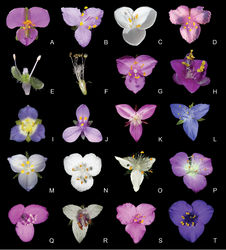Elasis guatemalensis
| Notice: | This page is derived from the original publication listed below, whose author(s) should always be credited. Further contributors may edit and improve the content of this page and, consequently, need to be credited as well (see page history). Any assessment of factual correctness requires a careful review of the original article as well as of subsequent contributions.
If you are uncertain whether your planned contribution is correct or not, we suggest that you use the associated discussion page instead of editing the page directly. This page should be cited as follows (rationale):
Citation formats to copy and paste
BibTeX: @article{Pellegrini2017PhytoKeys, RIS/ Endnote: TY - JOUR Wikipedia/ Citizendium: <ref name="Pellegrini2017PhytoKeys">{{Citation See also the citation download page at the journal. |
Ordo: Commelinales
Familia: Commelinaceae
Genus: Elasis
Name
Elasis guatemalensis (C.B.Clarke ex Donn.Sm.) M.Pell. comb. nov. – Wikispecies link – Pensoft Profile
- Tradescantia guatemalensis C.B.Clarke ex Donn.Sm., Bot. Gaz. 18(6): 210. 1893. Lectotype (designated here). GUATEMALA. Jalapa: Laguna de Ayarza, fl., fr., Sep 1892, Heyde & Lux 3886 (US barcode US00045211!; isolectotypes: NY barcode NY00039636!, P barcode P02173850!)
Nomenclatural notes
Hunt (1994) designated the specimen Heyde & Lux 3515 (K) as the lectotype for T. guatemalensis. This specimen was indeed examined by Clarke, being annotated as a new species and presenting drawings with diagnostic features for the new species. Nonetheless, after carefully analyzing the protologue and the collections of K, NY and P, I noticed that the collector’s number for the specimen at K is actually “3519”, which is annotated in the specimen by the original collectors and by Clarke, instead of “3515” as cited by Smith (1893). This lead me to conclude that Smith (1893) had limited access to this specimen, and probably did not base his diagnosis on it. Thus, the lectotype designated by Hunt (1994) must be disregarded, since the collector number is incorrect, and the specimen chosen by him does not correspond to a specimen of T. guatemalensis and was not cited in the protologue. On the other hand, the collection Heyde & Lux 3886 was clearly available to Smith, being housed at the NY, P and US herbaria, and was most probably studied by him. The US specimen is greatly preserved, presenting flowers and fruits, and is a good option for a lectotype. Thus, it is here designated as the lectotype of E. guatemalensis.
Taxon Treatment
- Pellegrini, M; 2017: Morphological phylogeny of Tradescantia L. (Commelinaceae) sheds light on a new infrageneric classification for the genus and novelties on the systematics of subtribe Tradescantiinae PhytoKeys, (89): 11-72. doi
Images
|
